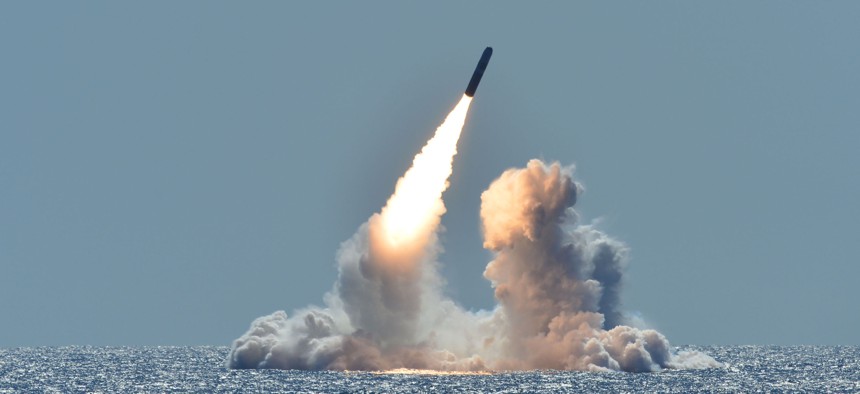
An unarmed Trident II D5 missile launches from the Ohio-class ballistic missile submarine USS Nebraska (SSBN 739) off the coast of California, March 26, 2008. U.S. Navy / Mass Communication Specialist 1st Class Ronald Gutridge
House Democrats Want To Kill This More Useable Nuke. They’re Right.
There are no good arguments for the W76-2 warhead, and quite a few good ones against.
After the 2018 midterm elections, it seemed likely that the new Democratic-led House would provide more aggressive oversight of the Trump administration’s unnecessary, unsustainable, and unsafe plans to augment the role of nuclear weapons and retreat from the longstanding U.S. leadership role on arms control and nonproliferation. So far, the House appropriations and armed services committees have done just that.
The early versions of the House’s 2020 defense and energy and water appropriations bills and national defense authorization act send a resounding message of concern about the new nuclear capabilities proposed in the Trump administration’s Nuclear Posture Review, or NPR, released in February 2018. Most notably, the legislation provides none of the requested $29.6 million for and prohibits fielding of the W76-2, a new and more usable low-yield warhead for submarine-launched ballistic missiles, or SLBMs.
Last week, the House Armed Services Committee rejected on party line votes two amendments offered by Rep. Liz Cheney, R-Wyoming, to allow the Defense Department to start deploying the new warhead. As House appropriators prepares to continue their work on appropriations bills this week, the full House will debate and likely vote on another Rep. Cheney amendment to the defense appropriations bill to reverse the prudent funding cut to the W76-2 made by the Democratic majority. This would be unwise. The case for the W76-2 is deeply and dangerously flawed.
The new nuclear warhead is a less powerful variant of the existing W76-1 warhead that arms Trident D5 SLBMs carried on Ohio-class nuclear ballistic missile submarines. Production of the W76-2 began last year and the Navy plans to begin fielding the warhead as soon as this fall.
Related: Nuclear Weapons Are Getting Less Predictable, and More Dangerous
Related: Nuclear Experts Beg Congress to Push Back on Trump Administration’s ‘Dangerous Impulses’
Related: New, More Usable Nukes for Trump? No.
The 2018 NPR justifies the addition of the W76-2, and in the longer-term a new low-yield nuclear-armed sea-launched cruise missile, to attempt to correct Russia’s purported “mistaken impression” that its larger arsenal of lower-yield nuclear weapons could “provide a coercive advantage in crises or at lower levels of conflict.” The NPR claims that a low-yield SLBM would provide the United States with a proportional, prompt, and assured response option that it currently lacks.
But adding new low-yield warhead option to the U.S. arsenal is a solution in search of a problem. The United States already possesses hundreds of low-yield warheads as part of the air leg of the nuclear triad and plans to invest scores of billions of dollars in the coming decades to ensure these weapons can penetrate advanced air defenses. On what basis does it make sense to invest such a large amount to upgrade these existing weapons if they cannot perform their intended mission?
In addition, the belief that a nuclear conflict could be controlled is dangerous thinking. The fog of war is thick; the fog of nuclear war would be even thicker. The W76-2 in particular could increase the risk of unintended nuclear escalation. Given that U.S. strategic submarines currently carry SLBMs armed with higher-yield warheads, how would Russia be able to tell whether an incoming missile was carrying low- or high-yield warheads? Even if it could, how would it know that such limited use would not be the leading edge of a massive attack? In fact, Russia would not know.
A low-yield SLBM is not necessary to promptly strike time-perishable targets. If military action has already started in the European theater and Russia uses a low-yield nuclear weapon to seek to end a conflict it believes NATO would win conventionally, it is likely that the United States would have had sufficient time to forward deploy forces, including conventional and nuclear fighters and bombers, to provide a timely response. Regardless, it’s far from clear why the United States would need or want to respond to Russian limited nuclear use in minutes, rather than hours or even days.
Finally, firing a single low-yield warhead from a strategic submarine could undermine the most survivable and important leg of the U.S. nuclear triad, which would be at a premium in the event of a potential nuclear conflict. As former Defense and Energy department official Madelyn Creedon has written: “Launching a high-value D5 missile from a ballistic missile submarine will most likely give away its location. China and Russia are expanding their ability to detect a missile launch and will be able to locate a U.S. submarine if it launches a D5 missile. Is having a low-yield warhead worth the risk of exposing the location of a ballistic missile submarine at sea?”
The answer to this question is clearly no.
For the past two years, the Republican majority in the House served as a rubber stamp for the Trump administration’s redundant and reckless effort to expand U.S. nuclear capabilities. Those days, it appears, are over. And not a moment too soon.
NEXT STORY: Iran Has Options and It’s Starting to Use Them



